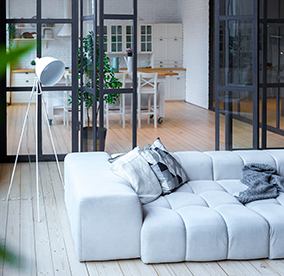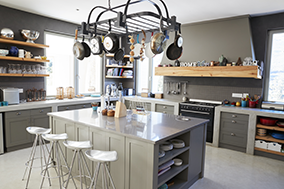Did you know that there are many homeowners who are considering selling their homes over the next few months? In fact, you might even be considering making a move yourself.
Why do I bring this up? Well, it’s conceivable that, while chatting with a neighbour or friend, you might be asked, “Do you know a good real estate agent?”
If that happens, I hope you’ll feel confident in recommending me.
I build my business through referrals. So, I work hard to earn those recommendations by providing excellent client service and doing everything else I can to be referral worthy.
In fact, that’s one of the reasons I send you this e-newsletter, containing helpful updates, tips and articles.
So, if you get asked to recommend an agent, and want to suggest someone who is committed to going the extra mile for clients, please give them my name.
I would really appreciate your support!
And, of course, I’ll give anyone you send my way the VIP treatment.

Why do I bring this up? Well, it’s conceivable that, while chatting with a neighbour or friend, you might be asked, “Do you know a good real estate agent?”
If that happens, I hope you’ll feel confident in recommending me.
I build my business through referrals. So, I work hard to earn those recommendations by providing excellent client service and doing everything else I can to be referral worthy.
In fact, that’s one of the reasons I send you this e-newsletter, containing helpful updates, tips and articles.
So, if you get asked to recommend an agent, and want to suggest someone who is committed to going the extra mile for clients, please give them my name.
I would really appreciate your support!
And, of course, I’ll give anyone you send my way the VIP treatment.
Balancing the Emotional and Practical Sides of Buying a Home

Imagine this scenario...
You’re shopping for a new home. You drive to visit a recent listing. As you walk through the front door, you’re impressed. Every room looks fantastic. You see yourself relaxing on the spacious patio, cooking in the modern kitchen, and enjoying evenings with the family in the cozy living room.
Your emotions are on overdrive. This is your dream home!
Should you make an offer? Probably. In fact, you should make that decision quickly in case there are other interested buyers.
However, your decision shouldn’t be guided purely by emotion. You want to make sure you take practical matters into consideration too.
For example, you’ll want to consider:
Should you make an offer? Probably. In fact, you should make that decision quickly in case there are other interested buyers.
However, your decision shouldn’t be guided purely by emotion. You want to make sure you take practical matters into consideration too.
For example, you’ll want to consider:
*Is the property within your price range?
*Does it have everything you need?
*Do you like the neighbourhood?
*How old is the property? Are there items, such as the furnace, that may need to be replaced soon?
*Will it need any major repairs or upgrades?
*What are the average monthly costs of carrying the home? (Property taxes, utilities, etc.)
*Once you’ve considered the purchase of the home from a practical standpoint, you’ll have a lot more confidence in your decision when you make an offer.
Need help? Call today!
 Need more storage space in your kitchen for your growing collection of cookware, tableware, and supplies? You don’t have to do a renovation or even add a new table or cupboard. Here are a few simple ideas:
Need more storage space in your kitchen for your growing collection of cookware, tableware, and supplies? You don’t have to do a renovation or even add a new table or cupboard. Here are a few simple ideas:
Need help? Call today!
Create More Space in your Kitchen
 Need more storage space in your kitchen for your growing collection of cookware, tableware, and supplies? You don’t have to do a renovation or even add a new table or cupboard. Here are a few simple ideas:
Need more storage space in your kitchen for your growing collection of cookware, tableware, and supplies? You don’t have to do a renovation or even add a new table or cupboard. Here are a few simple ideas:Pantry dividers. These enable you to store baking sheets, cutting boards and platters in an upright position, effectively doubling the storage capacity of that area.
Removable wine rack. This is simply an X made with wood and then slid into a cabinet space. You can make one yourself or find one that’s the right size at a kitchenware or home improvement store near you.
Hanging baskets. These are ideal for storing cooking utensils, fruit, vegetables, pasta and other items.
Hanging rod. This is similar to a towel rack, except you use S-shaped hooks – which you can find at any home improvement store – to hang pots, pans and other items. Restaurant kitchens often use these.
High shelving. A shelf installed high up the wall – near the ceiling – that wraps around the kitchen and dining area, can easily double your storage space.
There are many other products on the market that can help you make the most of your kitchen space. Look for options at your local home improvement or kitchenware stores.

There are many hidden sources of moisture in your home that can lead to serious problems, such as mould.
To keep moisture levels in check, consider these tips:
Removable wine rack. This is simply an X made with wood and then slid into a cabinet space. You can make one yourself or find one that’s the right size at a kitchenware or home improvement store near you.
Hanging baskets. These are ideal for storing cooking utensils, fruit, vegetables, pasta and other items.
Hanging rod. This is similar to a towel rack, except you use S-shaped hooks – which you can find at any home improvement store – to hang pots, pans and other items. Restaurant kitchens often use these.
High shelving. A shelf installed high up the wall – near the ceiling – that wraps around the kitchen and dining area, can easily double your storage space.
There are many other products on the market that can help you make the most of your kitchen space. Look for options at your local home improvement or kitchenware stores.
Avoiding Moisture Problems in the Home

There are many hidden sources of moisture in your home that can lead to serious problems, such as mould.
To keep moisture levels in check, consider these tips:
*Bathrooms are an obvious source of moisture build-up. Contractor and TV personality Mike Holmes recommends keeping the fan going for at least half an hour after a shower.
*Check regularly for water infiltration around window and door sills, as well as other intakes into the home, such as dryer vents and cable wiring.
*Determine the humidity level in your home. According to the Environmental Protection Agency, it should be 30-60%. (Keep in mind that humidity may vary greatly from room to room.)
*Regularly inspect caulking around sinks, tubs and showers. Even a tiny break can cause water to leak gradually into the wall or floor, causing damage you may not notice for months.
*Clean up wet spills as soon as possible. Be particularly careful with hardwood floors, as water can seep through and become trapped.
*Repair leaking faucets and pipes immediately. Even a small drip can add significant moisture inside a vanity or kitchen cupboard.
Being mindful of moisture today can help you avoid potentially high repair bills later on.
Being mindful of moisture today can help you avoid potentially high repair bills later on.